Making vegan meat is easy with this flavor-packed seitan recipe. While there are many ways to make seitan, some are quite labor-intensive. This recipe is for those who want a delicious seitan with a great texture and minimal work.
The recipe takes a while to bake, but you can prepare it in about 20 minutes. You can also customize it with any flavor combinations you may be looking for as a vegan. It’s a great source of vegan protein and is perfect for meal prep.
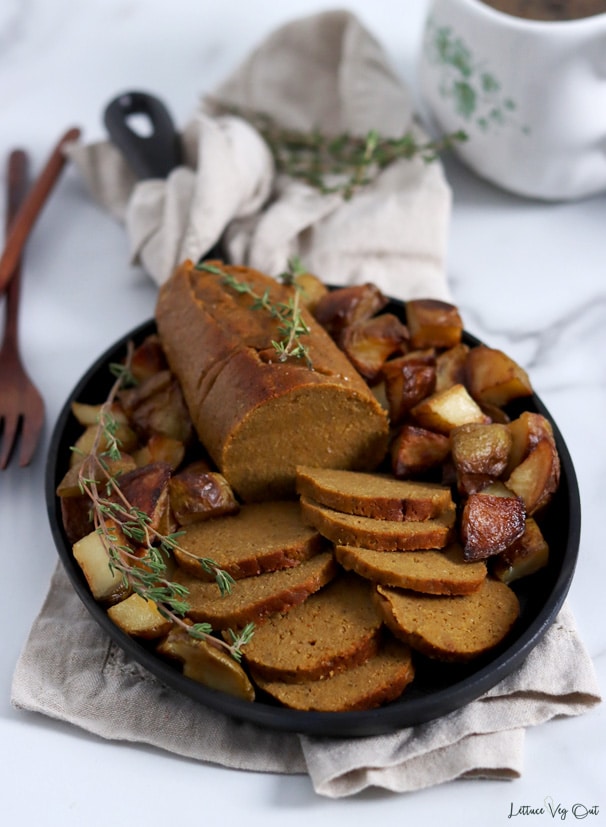
This post contains affiliate links (including Amazon Associates) and I earn from qualifying purchases.
What is Seitan? Is it Vegan?
Seitan is almost always vegan. It’s a meat alternative made from the protein found in wheat flour, which is why some people call seitan “wheat meat”.
There are two common methods used to prepare seitan.
One requires you to make dough from wheat flour, then wash out the starch, leaving behind just wheat protein. This is called the “washed flour method” and has become popular on social media.
This first method creates a stringy seitan that replicates the texture of meats like chicken quite well. However, it’s a lot of work to prepare and requires large amounts of flour to create relatively small amounts of seitan.
The other common method to prepare seitan starts with gluten flour, also called vital wheat gluten. Since seitan uses only the protein in wheat flour, it’s much faster and easier to start with the protein in its pure form.
With this second method, the only steps required are to mix dry ingredients with liquid then cook it. Many people steam seitan; while this is an option, I like to simply bake mine in an oven. This is, in my opinion, the easiest way to make seitan.
You won’t end up with a super stringy “meat” texture with gluten flour, but rather a firm, chewy meat alternative. How chewy and firm the seitan is depends on other ingredients you might use. This recipe mixes in beans for a softer texture, but there are times when skipping the beans and creating a fully firm texture is more desirable.
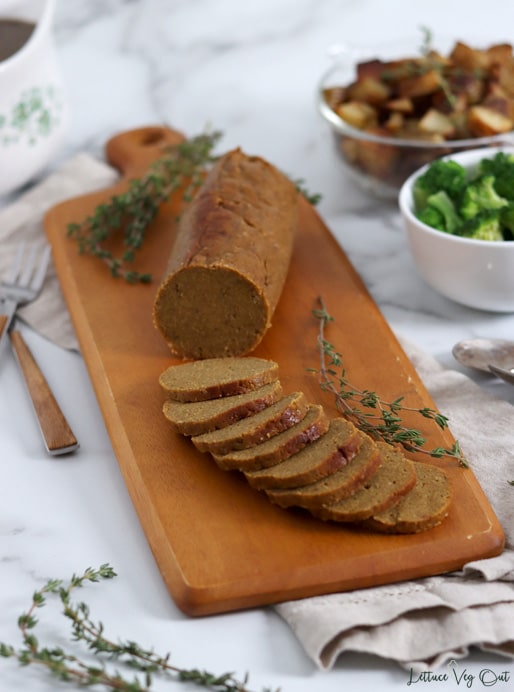
Ingredients and Substitutions for Easy Seitan
This recipe has a long ingredient list but have no fear! Gluten flour has doesn’t taste like anything, so you’ll want to add lots of herbs, spices and other tasty ingredients.
This recipe creates what I’d consider a “middle-of-the-road” seitan. It tastes delicious but not specifically like chicken, beef or pork; it’s somewhere in between.
Play around with spices in this recipe to create whatever flavors you want. Just keep the ratio of liquid to dry ingredients as-is, otherwise its texture won’t turn out well. So, if you significantly increase or reduce the amount of any one ingredient, replace it with the same amount of some other dry or liquid ingredient.
Dry Ingredients
- Vital wheat gluten (gluten flour): This recipe’s base uses vital wheat gluten, as opposed to regular flour, which is another way to make seitan. Gluten is the protein found in wheat, and is essentially extracted from the grain. Staring with gluten flour makes preparing seitan incredibly quick and easy (compared to the “washed flour method” which requires quite a lot of work).
- Nutritional yeast: I love the flavor this ingredient adds to any recipe! It’s also a great vegan source of vitamin B12.
- Herbamare: This specialty ingredient is a blend of sea salt, vegetables and herbs. It adds a nice flavor to recipes, like a bouillon cube that’s less concentrated. If you don’t have Herbamare and don’t want to buy it, substitute for half salt and half an herb blend of your choice. For this recipe, since you’ll use salt and lots of herbs elsewhere, you could also skip this ingredient.
- Smoked paprika: Many meats taste smoky and using smoked paprika is an easy way to add that flavor. If you aren’t a fan of smoke flavor, use a regular or sweet paprika.
- Onion and garlic powder: If you’re only using a few spices, these are the two I’d start with for a basic (but delicious) flavor.
- Cumin: I love the smoky flavor of cumin. Like with smoked paprika, if you don’t want a smoke flavor, just skip this ingredient.
- Sage: As I’ve mentioned, this seitan recipe tastes very meaty but not like any one type of meat. However, sage is a potent herb that creates a savory, roasted flavor that I associate with roast chicken.
- Turmeric: I like to use this spice mainly for coloring because its flavor doesn’t come through in the final seitan. Turmeric, like most spices, is optional.
- Celery seed: Celery seed pairs well with sage to create more of a roast chicken flavor. It’s also optional, as is every spice in this list!
- Dry oregano: Some oregano really helps to round out the seitan’s flavors. As with all other ingredients, play around with the types and amounts of spices to get a flavor that you enjoy.
- Salt and pepper: Always add these ingredients to taste. Keep in mind there’s salt in other parts of the recipe, but also that gluten flour has no flavor and salt is key to making vegan meat alternatives taste good.
Wet Ingredients
- Baked beans: Adding beans to seitan helps change its texture. Making seitan solely with gluten flour creates a very firm, chewy texture. This is great for some recipes (like vegan seitan ham) but adding blended beans makes for a more tender meat. I like to use “beans in tomato sauce” as I can use its tasty liquid to flavor the seitan.
- Onion: I blend some onion into the bean mixture for extra flavor. Garlic would also be a tasty choice.
- Bouillon cube: A bouillon cube is an easy addition that provides lots of flavor. While most bouillon cubes should mix with large amounts of liquid, this recipe only uses ⅓ of a cup to maintain the ideal liquid to dry ingredient ratio.
- Olive oil: I typically use olive oil or avocado oil to give this recipe some fat. Any liquid oil can work. This creates a satisfying vegan meat and prevents the seitan from being dry and tough.
- Soy sauce: This is another ingredient I highly recommend adding for a great umami flavor and saltiness. Tamari or a soy-free alternative like coconut aminos can work too.
- Apple cider vinegar: Some acid is always welcome to create a tasty recipe. While there’s only a small amount of vinegar, I wouldn’t skip it. Pretty much any other type of vinegar could work for this recipe, but I always keep apple cider vinegar on hand.
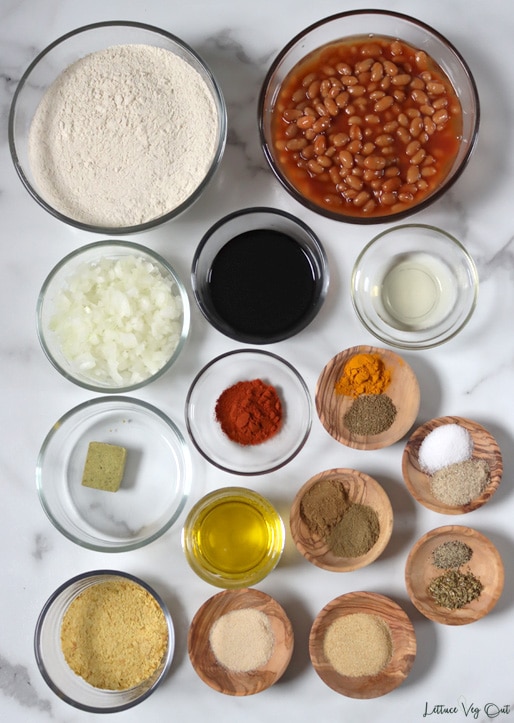
How to Make Vegan Meat: Instructions and Tips
Ready to learn how to make vegan meat?! Read the detailed instructions below which takes you through each step. I promise it’s easy!
Step 1: Whisk Dry Ingredients
Start with a large mixing bowl and add vital wheat gluten along with all the dry spices.
When making this recipe, I include nutritional yeast, smoked paprika, onion powder, garlic powder, cumin, sage, Herbamare, salt, turmeric, celery seed, dry oregano and black pepper.
Whisk everything until well combined and there are no clumps of spices left.
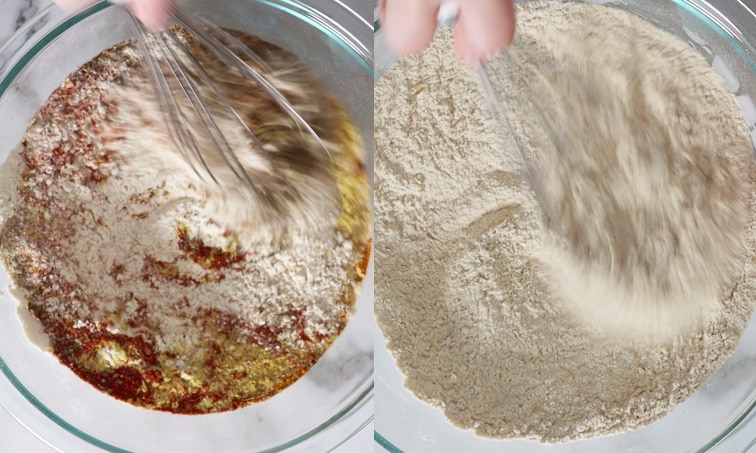
Step 2: Prep Wet Ingredients
Next, mix the wet (liquid) ingredients together. I do this in a food processor as it’s quick and easy. A blender could also work.
Start by adding the can of baked beans, including all the liquid. Then add onion. I like to pre-chop onion to make sure there aren’t any large pieces that remain once blended.
Pulse these ingredients to combine and start breaking down the beans.
Then mix your bouillon cube with ⅓ cup of hot water. I mash a cube into the water then dump it into my food processor.
Add olive oil, soy sauce and apple cider vinegar as well.
Blend until everything is nicely combined. You can puree to smooth or leave some texture, whatever you prefer.
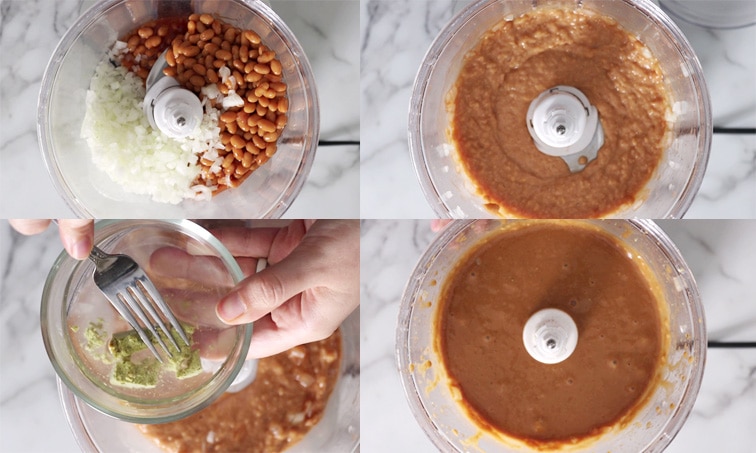
Step 3: Form Seitan
Pour your liquid mixture into the bowl of whisked dry ingredients. Use a spoon to stir until a ball of dough starts to form.
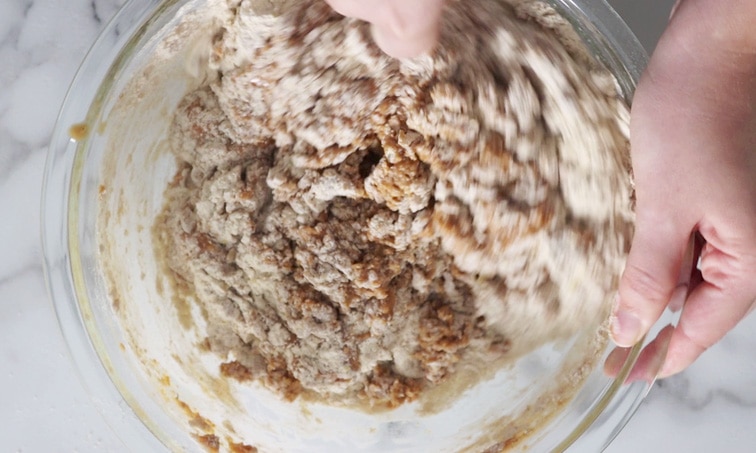
At this point, switch to using your hand and knead the dough until no dry bits of flour remain. At this point, knead the dough for about another minute to work the gluten flour a bit more.

Then cut the dough in half or rip it into halves using your hands. These don’t have to be exactly the same in size, but similar sized pieces will cook more evenly.
Prep four sheets of tin foil that are each about a foot long.
Place one sheet on your counter and set one half of seitan dough onto it. You can form the seitan into any shape you like, but I find a log shape cooks the best (the rounder the dough is, the longer it takes to cook through to the center).
When you’ve formed the seitan log, wrap it tightly in tin foil. Once you’ve wrapped the log with one sheet of tin foil, place its open edge down onto a second sheet and wrap tightly again. Place the open edge of this second tin foil sheet onto your baking tray.
Repeat the shaping and wrapping process for your second half of seitan dough.
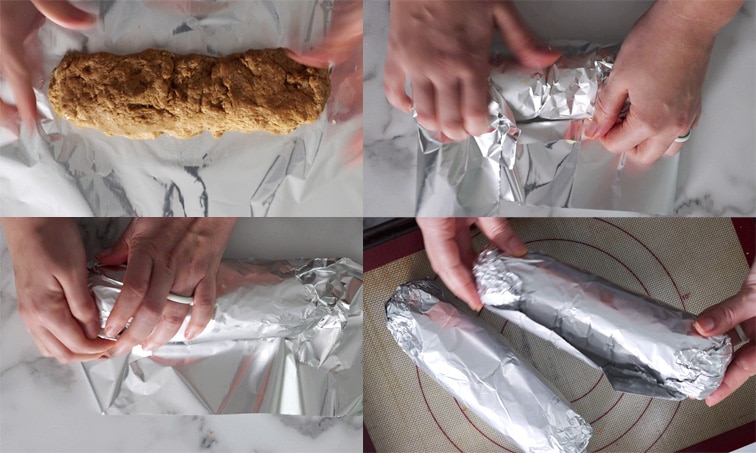
Step 4: Bake, Cool and Serve
When you’ve wrapped both pieces of seitan and placed them on a baking tray, put them into an oven preheated to 350 °F.
Bake for 1 hour and 20 minutes. If possible, flip the seitan halfway through.
Once out of your oven, allow the seitan logs to cool. When they’re cooled enough to handle, remove from tin foil and place onto a cutting board or wire cooling rack.
You can serve hot from the oven, but the seitan will be quite soft until cooled completely. This is fine if you’re okay with a softer texture (it’ll also be harder to slice).
Seitan has a better texture after it’s had time to cool completely and has the best texture after refrigerating. While this takes some planning, if you can wait until the next day to eat the seitan, I highly recommend it.
Once your seitan cools to room temperature, use the tin foil it was cooked in to refrigerate overnight (or place it into an airtight container).
It’s best to slice the seitan with a serrated knife, especially if you want thin slices.
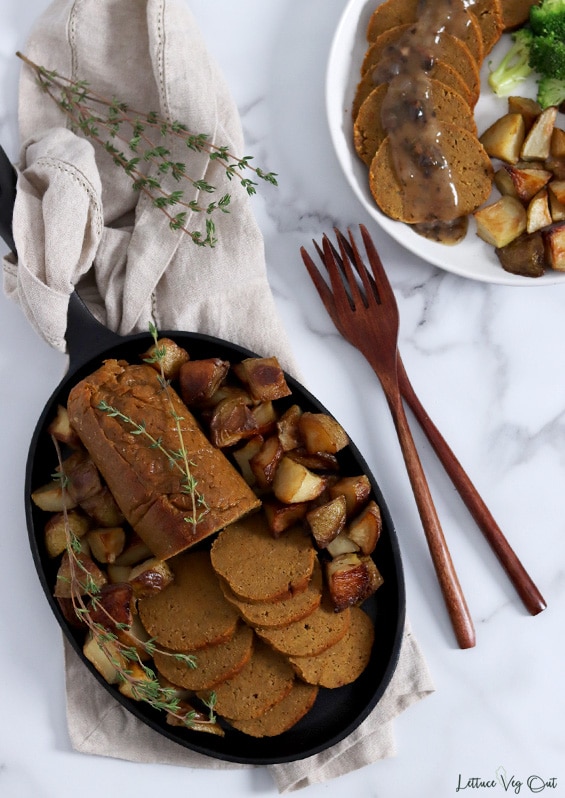
How to Create a Balanced Vegan Meal with Seitan
You can serve this seitan however you would serve meat. It’s great in a “roast” meal alongside potatoes and veggies. It also makes a great sandwich or wrap and can be tossed into salad or pasta dishes.
I consider a balanced meal one that contains plant-based protein, carbohydrates, healthy fats and plenty of veggies (or fruits).
This seitan recipe is incredibly high in protein due to the vital wheat gluten. It also has some carbohydrates from the beans and some healthy fats from the olive oil.
This means all you need is to add some veggies and you’ll have a complete meal.
However, I typically view seitan as just a source of protein and add additional sources of carbohydrates (ex. potatoes or bread) to the meal. I’ll usually add more healthy fats too, depending on what I serve the seitan with.
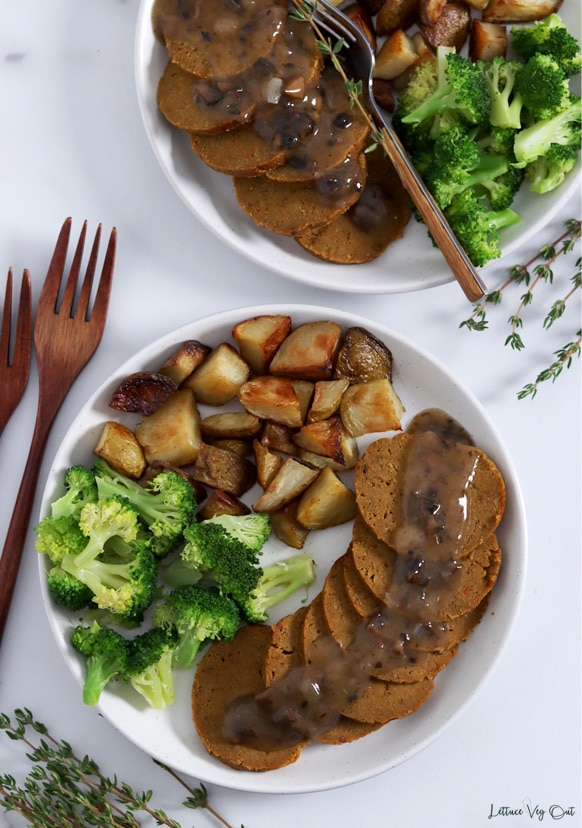
Easy Seitan Variations
There are countless ways to make seitan. If you keep the ratio of dry to liquid ingredients on track, you can easily make this recipe taste however you like.
I highly recommend testing different flavor combinations to create new seitan varieties!
If you’re looking for more seitan recipes, here’s some of my favorites:
- Vegan ham with pineapple glaze (glaze optional)
- Vegan gyros (served with tzatziki sauce)
- Vegan donair (with sweet sauce)
- Vegan BBQ “ribs” (seitan with jackfruit that you can grill!)
If you’re hesitant to make seitan for the first time, I understand. I was too! However, I was so happy I gave it a try because it’s a staple recipe in my house now!
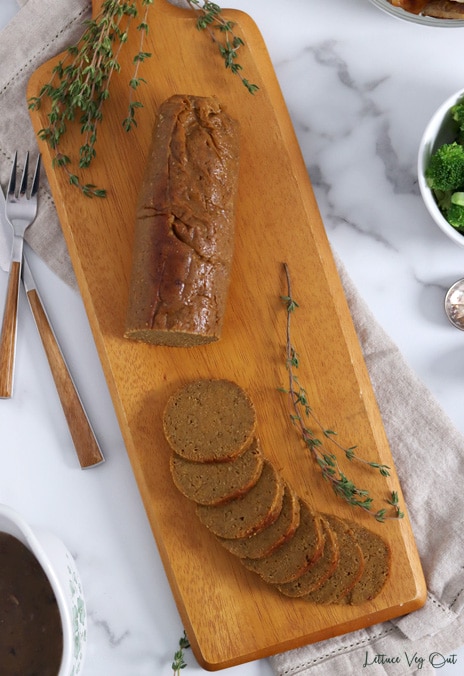
How to Store Leftover Vegan Meat
Let the seitan cool for about an hour at room temperature before refrigerating. Store it in the tin foil you cooked it in, or an airtight container.
Seitan should last in your fridge for up to a week. This makes it a great recipe for meal prep! I’ve yet to test how this (or any other) seitan recipe freezes because we eat it all before I remember to freeze some! However, it lasts quite well in the fridge. If you’re concerned about making a large amount, just cut the recipe in half.

📖 Recipe

Easy Vegan Seitan "Meat" Recipe
Equipment
- Tin foil
Ingredients
Dry Ingredients
- 2 cups gluten flour
- 3 tablespoons nutritional yeast
- 2 teaspoons smoked paprika
- 1 ½ teaspoons onion powder
- 1 ½ teaspoons garlic powder
- 1 teaspoon ground cumin
- 1 teaspoon ground sage
- 1 teaspoon Herbamare seasoning*
- 1 teaspoon salt
- ½ teaspoon ground turmeric
- ½ teaspoon celery seed
- ½ teaspoon dry oregano
- ¼ teaspoon ground black pepper , or to taste
Wet Ingredients
- 2 cups baked beans in tomato sauce (400mL / 14 oz can)
- ⅔ cup onion , finely chopped
- ⅓ cup water , hot
- 1 cube vegetable bouillon
- ¼ cup olive oil (or other liquid oil of your choice)
- 3 tablespoons soy sauce , low sodium
- 1 tablespoon apple cider vinegar
Instructions
Step 1: Whisk Dry Ingredients
- In a large mixing bowl, add the gluten flour along with all the dry spices.2 cups gluten flour, 3 tablespoons nutritional yeast, 2 teaspoons smoked paprika, 1 ½ teaspoons onion powder, 1 ½ teaspoons garlic powder, 1 teaspoon ground cumin, 1 teaspoon ground sage, 1 teaspoon Herbamare seasoning*, 1 teaspoon salt, ½ teaspoon ground turmeric, ½ teaspoon celery seed, ½ teaspoon dry oregano, ¼ teaspoon ground black pepper
- Whisk the dry ingredients until well combined.
Step 2: Prep Wet Ingredients
- Add a full can of baked beans, along with all its liquid, to a food processor.2 cups baked beans in tomato sauce
- Add onion to the food processor as well. I like to pre-dice the onion to ensure there are no large pieces in the final mixture.⅔ cup onion
- Pulse the beans and onion a few times.
- Then, mix a bouillon cube with ⅓ cup of hot water. Mash the cube to dissolve, then add this mixture to your food processor.1 cube vegetable bouillon, ⅓ cup water
- Add olive oil, soy sauce and apple cider vinegar to the food processor then pulse a few times, until everything is well combined.¼ cup olive oil, 1 tablespoon apple cider vinegar, 3 tablespoons soy sauce
- Blend this mixture until completely smooth or leave some texture (but it should be almost completely smooth).
Step 3: Form Seitan
- Add your blended liquid ingredients to the dry ingredients in the large mixing bowl. Stir together until a ball of dough forms and you can no longer stir.
- At this point, switch to using your hands and knead the dough together until there’s no dry flour remaining. Knead for about another minute.
- Cut the dough in half.
- Prepare 4 pieces of tin foil, each about a foot long.
- Place one half of the seitan dough onto a piece of tin foil and shape into a log. Wrap the seitan log tightly in tin foil.
- Place the open edge of your first tin foil sheet down onto a second sheet and wrap the log tightly again. Place this open edge of tin foil down onto the baking tray.
- Repeat the shaping and wrapping process for the other half of the seitan dough.
Step 4: Bake, Cool and Serve
- Bake the seitan in an oven preheated to 350 °F for 1 hour and 20 minutes. If possible, flip the seitan logs halfway through cooking.
- Once out of your oven, let the seitan cool until you can unwrap it without burning yourself on the tin foil.
- Cool on a cutting board or wire cooling rack.
- Serve the seitan hot from your oven (softer texture) or let the seitan cool for at least an hour (firmer texture). The seitan will be most firm and chewy if you can chill it in a fridge overnight.
- Slicing with a serrated knife is very helpful, especially if you want thin slices.
Notes
Nutrition
More Vegan Meat Recipes
Like this recipe? You should also try:

About Nicole Stevens
Nicole is a long-time vegan with a Masters of Science in Food and Nutrition.
She helps people thrive on a vegan diet with balanced recipes.

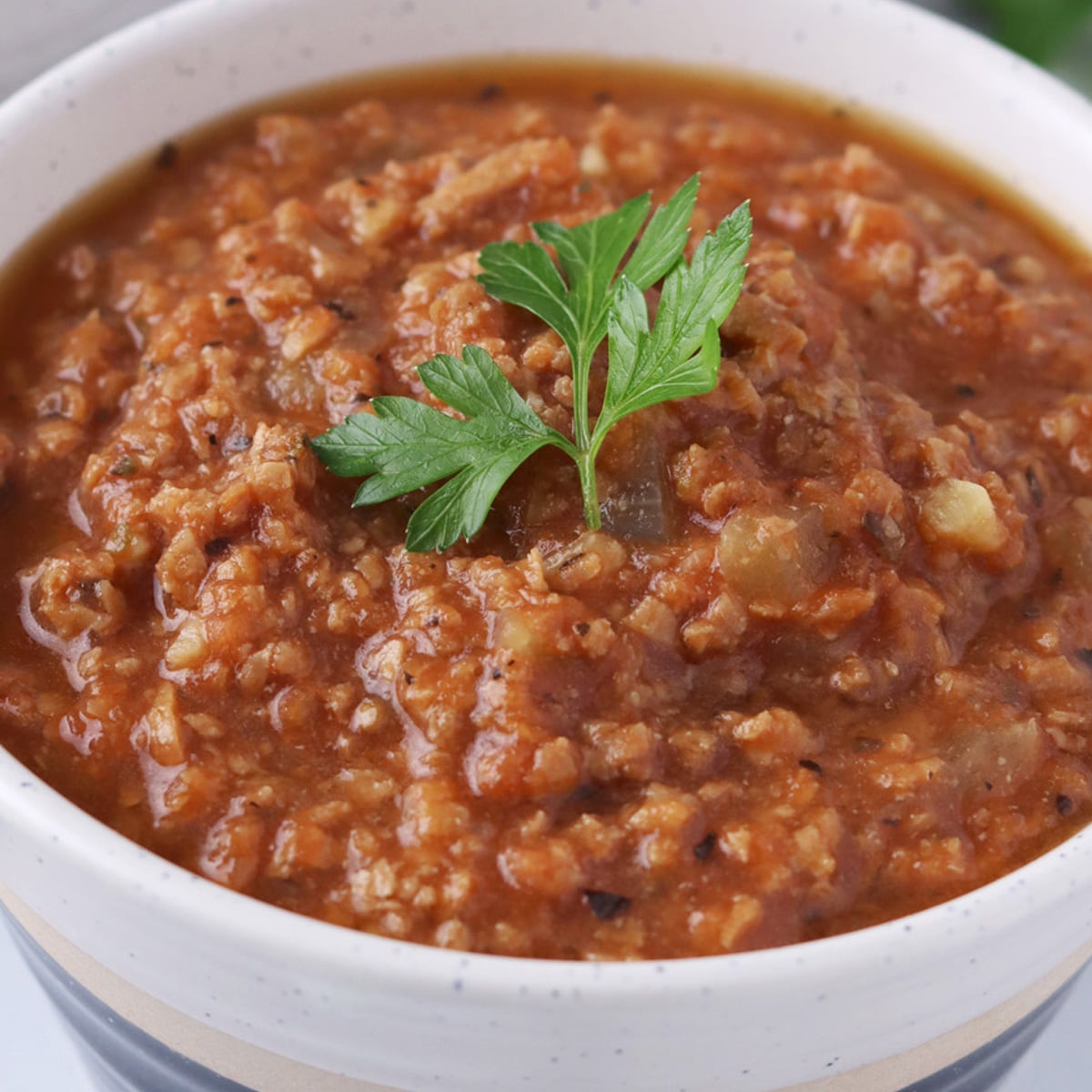
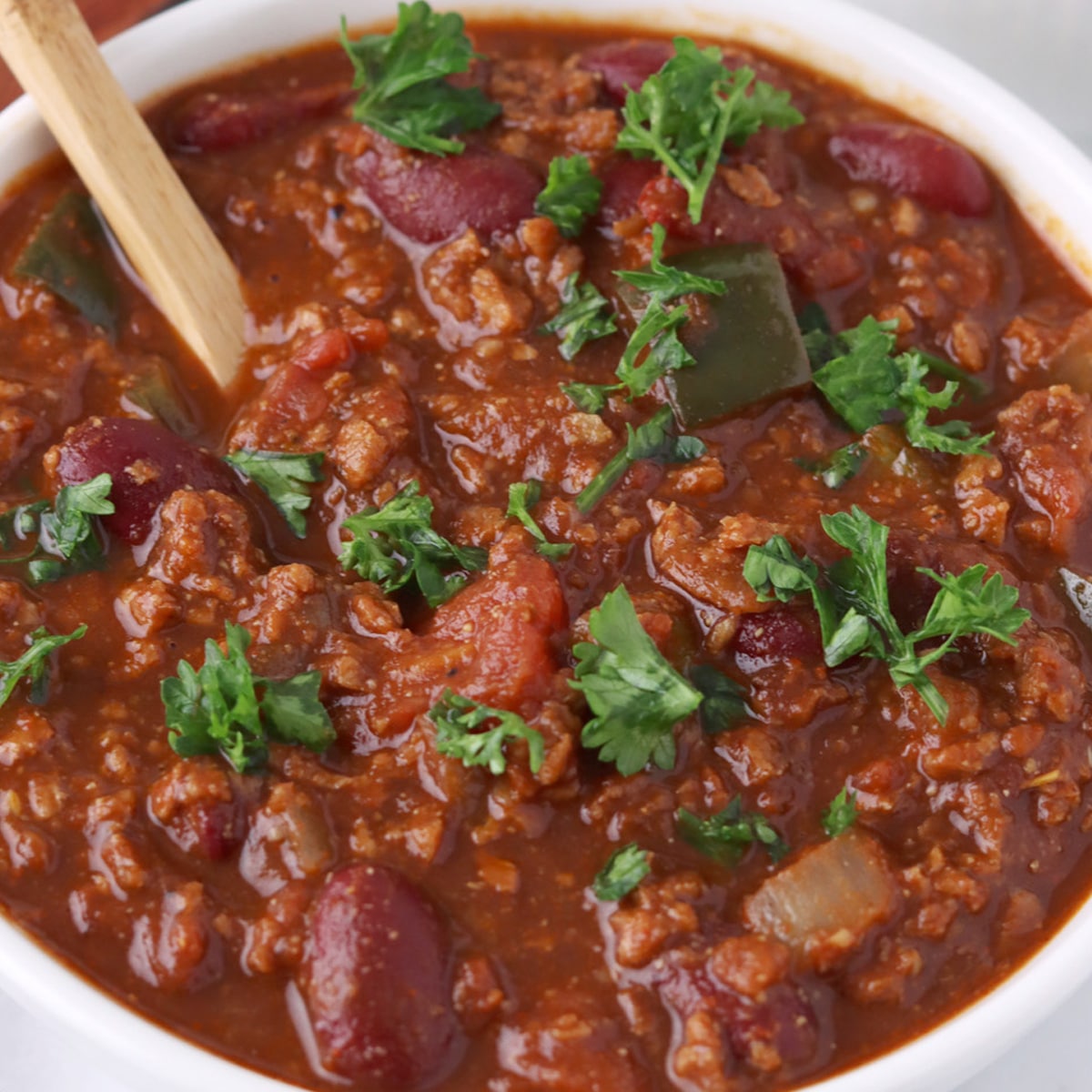


Sheri says
Celery seed: Is that whole or ground?
Nicole says
I use whole seeds since they're so small. I'd guess ground would work fine but haven't tried it.
Kim says
Hello, Chef,
I have tried many seitans but to my taste buds, this is the best one. Very very good. I am wanting a seitan that tastes similar to corned beef. Any suggestions or recipe?
Nicole Stevens says
Hi Kim! Thank you so much for this comment, I'm happy you enjoyed the recipe. I haven't tried making vegan corned beef before so unfortunately don't have any recommendations.
Jacqui says
Thank you for the recipe - my first time making seitan. I'm not sure if it's just my palate, but I found this overly salty. I'd leave out the sale next time as the stock and soy sauce plus salt were just too much. Just a warning for anyone else that doesn't like things too salty.
Nicole says
Sorry you found this too salty but thanks for the feedback. I've never found it too salty but everyone has different taste preferences and this may be helpful for others to know before they make it 🙂
Tacy says
This is the best tasting and best textured seitan I’ve ever made. Thank you so much. Now what recipes do you suggest I use it in?
Nicole Stevens says
Thank you so much! I typically make this for a "meat and potato" type meal with a side of veg but you can use it however you like. It's great chopped up in pasta dishes or on pizza, in a wrap with salad greens and dressing; literally however you'd use "meat"!
Neale Aslett says
I made this yesterday (doubled the quantity) and used vegan refried beans as I do not have a food processor ans lots of whole garlic cloves and mixed up the spice components a little. I baked for an extra 10 minutes (just because) & after a day in the fridge it is amazingly firm and flavourful and is the tastiest seitan I have made.
Nicole Stevens says
Refried beans is such a great idea!! So happy you enjoyed it 🙂
Alistair Brown says
Hi just made this, and put in oven, smells good even b4 I put it in oven can't wait to taste it! Thank you for the recipe, I am not vegan yet but heading that way! Can't stomach meat any more!
Nicole Stevens says
So glad you're happy with it so far! And enjoy the journey towards veganism 🙂
Alistair Brown says
Thank you was tasty and have made Turkey seitan as well glad I found you and seitan!
Stephanie says
How long can seitan be stored in fridge? Can it be frozen?
Nicole Stevens says
Hi Stephanie! This seitan can be stored in the fridge for at least 5 days, up to 7 should be fine. I haven't tried freezing any of my seitan recipes yet so unfortunately can't say (but that's definitely something I need to test out)! If you want to test it out, maybe try freezing/ thawing out one slice?